OKX announced the launch of the AA smart contract wallet, which may change the blockchain industry forever and lower the barrier for internet users to enter Web3.
Preface
"This article aims to help new users understand and try to use Web3 wallets in the most straightforward language, so as to join the new wave as soon as possible."
Currently, there are nearly 5 billion Web2 users globally, while Web3 users are only 400 million, making Web3 still a niche industry. As an entry-level application, the popularization of Web3 wallets will help Web3 achieve large-scale applications.
On August 2nd, OKX announced the launch of the AA smart contract wallet, which may change the blockchain industry forever and lower the barrier for internet users to enter Web3.
Ethereum founder Vitalik Buterin has emphasized multiple times that smart contract wallets are the future of Web3 wallets. In addition, in his summary speech at the EthCC conference, Vitalik Buterin emphasized that future account abstraction (AA) will make encrypted wallets as simple as email. In the Ethereum 2.0 roadmap, the official account abstraction (AA) is placed in the same directory level as merge and sharding, indicating the important position of account abstraction in the Ethereum ecosystem.
Introduction to Web3 Wallets
Setting aside the concept of Web3, in fact, Web3 wallets are no different from WeChat and Alipay in terms of their attributes; they are payment tools. With this basic reference, it is easy to understand Web3 wallets. Web3 wallets are mainly used for receiving, storing, managing, and transferring digital assets, as well as exploring DApps, and so on.
If we add back concepts such as decentralization to Web3, the biggest change of Web3 wallets compared to traditional payment tools is: allowing users to control their private keys and assets completely, thus eliminating the reliance on third-party intermediaries such as banks and financial institutions. In other words, even in the event of a black swan event like the collapse of a Silicon Valley bank or doomsday, your assets will still be in the Web3 wallet, controlled by the private key.
A Web3 wallet corresponds to a unique private key and cannot be modified. The private key is a 64-bit hexadecimal string composed of letters and numbers, simplified into a 12-word mnemonic phrase for easy memorization and recording. Therefore, the private key is crucial; whoever controls the private key controls the assets. Three types of wallet control rights are derived from the control of the private key, including custodial wallets, hybrid custodial wallets, and non-custodial wallets, where the private key is respectively controlled by the user, the user and the custodian. Currently, mainstream wallets such as Metamask and OKX Web3 wallets belong to non-custodial wallets (or self-custodial wallets).
Although non-custodial wallets return asset control to users, they face many pain points such as difficulty in memorizing mnemonic phrases, limited GAS payment methods, and complex operation processes, which are significant obstacles for new users. In order to solve these problems, wallets represented by OKX Web3 wallet continuously explore new technologies and methods, accelerate product updates and iterations, aiming to create a leading digital wallet that is more user-friendly and secure. The launch of the OKX AA smart contract wallet ensures asset security while providing more custom and extended functions such as batch transactions, gas payment delegation, and private key recovery. It not only eliminates the constraints of mnemonic phrases/private keys to improve security, but also simplifies the process of on-chain interaction, and can automatically provide gas subsidies, reducing the barrier for users to use Web3 wallets. It may usher in the "iPhone moment" for Web3 wallets, help achieve large-scale Web3 applications, and open up huge imagination space.
Opportunity
Why did OKX launch the AA smart contract wallet?
The "AA" in the AA smart contract wallet stands for Account Abstract, so the AA smart contract wallet is also called a smart account or account abstraction.
To understand what account abstraction is, it can be divided into two parts: "account" and "abstraction." First, let's understand some background knowledge about Ethereum accounts.
Almost everyone now has a financial platform account. Ethereum accounts, like ordinary financial accounts such as bank cards, Alipay, and WeChat, can intuitively display the account balance. What makes Ethereum accounts special?
Unlike the Bitcoin network, Ethereum accounts not only support simple token transactions but also support complex smart contracts. Therefore, Ethereum has two types of accounts: Externally Owned Accounts (EOA) and Contract Accounts (CA). Currently, all wallets are built based on these two account types, and the differences between the two are directly compared in the following image.
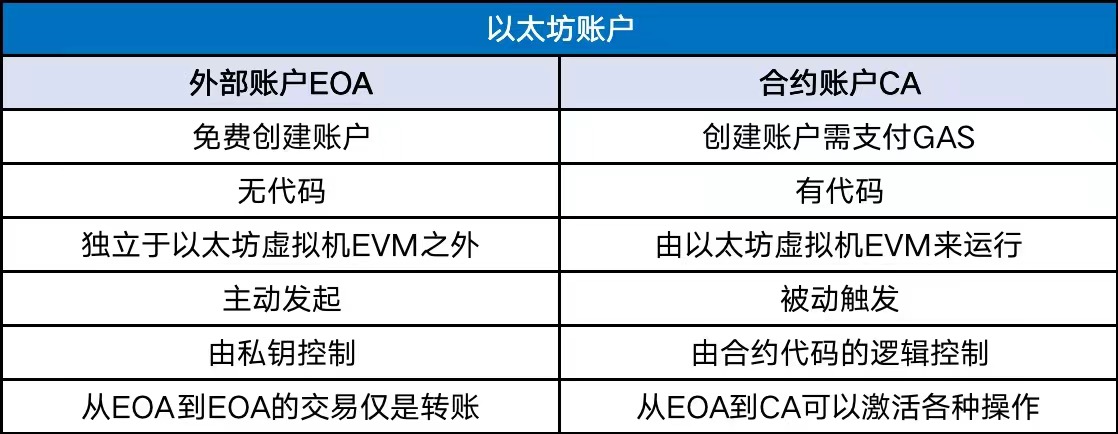
How do Ethereum accounts work? For example, if Xiaoming creates EOA account A and Xiaoli creates EOA account B, and Xiaoming wants to buy 1 ETH worth of apples from Xiaoli, can he transfer directly from account A to account B? No, he must use CA account C.
Why? Because what if Xiaoli refuses to pay after Xiaoming transfers money to her? Or what if Xiaoli ships the goods to Xiaoming but Xiaoming refuses to pay? A smart contract can be deployed to create CA account C. At this point, accounts A and B both transfer 2 ETH to account C. After Xiaoli ships the goods, account C is triggered to transfer 1 ETH to account A and 2 ETH to account B.
This is the basic explanation of Ethereum accounts. Next, let's talk about "abstraction." To help everyone understand account abstraction in a simple way, let's take an example. In the summer, we don't need to understand how the air conditioner works internally. We can control the temperature and fan speed through the remote control, which abstracts the internal operation of the air conditioner to the surface. With this basic concept, it is easier to understand the "abstraction" of accounts.
EOA carries wallets, and CA carries the logic of smart contracts, each with its own advantages and disadvantages.
Unlike traditional bank accounts, for EOA accounts, because their "ownership" and "signing rights" are integrated and controlled by a unique private key, various problems arise. Why? The "ownership" is the person who owns the account, and the "signing right" is the person who can control the account. For traditional bank users, even if a thief steals or loses the password "signing right," others cannot transfer your assets "ownership" from the bank. However, for Ethereum EOA accounts, as long as you hold the private key, you can fully control the assets in the account. Therefore, EOA accounts currently face many pain points such as difficulty in saving private keys, high signing authority, and losing the private key means losing all assets. Imagine a scenario where the money is still in the wallet, but the private key is lost, and the money cannot be recovered. In addition, it lacks programmability and requires ETH as gas fees to operate, among other pain points.
For CA accounts, there are also problems. Although it can customize logic to achieve more functions, it cannot initiate transactions actively and must be called by an EOA account. Additionally, because it is deployed on the chain, it requires additional GAS and waiting.
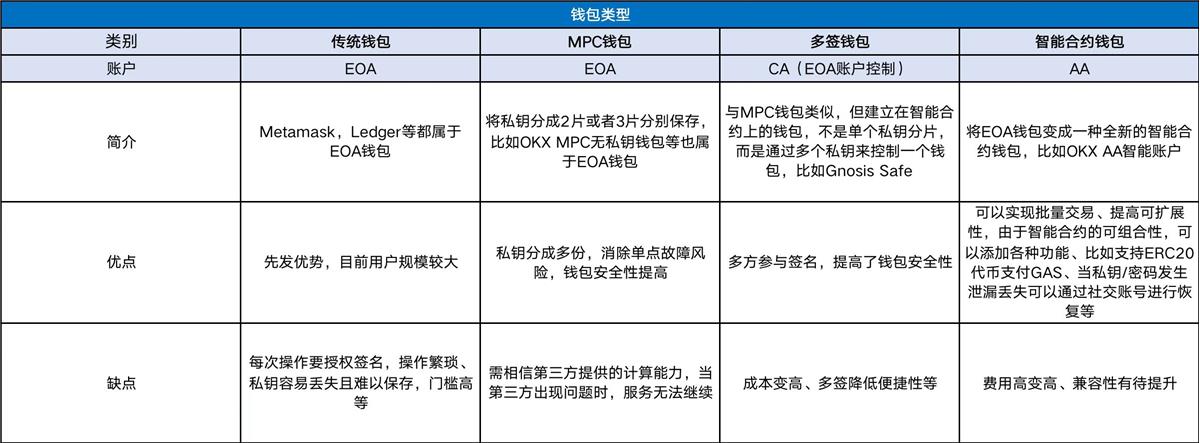
It is clear that neither of these account types can currently solve the complex problems of wallet usage, and they are both unsafe. Therefore, the AA smart account abstracts the complex operation logic of CA and EOA, simplifying the two types of Ethereum accounts into one type. This account type will be able to support both cryptocurrency transactions and smart contracts, combining the programmability of CA with the ability to eliminate the reliance on EOA for initiating transactions, separating "ownership" and "signing rights," and combining the advantages of both. This can achieve various new features such as multi-signature, batch transactions, gas payment delegation, social recovery, and more, without the need to distinguish between account types.
In other words, the wallet is also a contract, allowing the AA smart contract wallet to expand into diverse functions.
The development of account abstraction is inseparable from the Ethereum environment. It was proposed early in the launch of Ethereum, but most solutions were not mature or difficult to implement, so they were shelved. From the earliest EIP-101 to EIP-3074, several versions have been iterated. The real implementation is based on the proposal of ERC-4337, which aims to achieve flexibility and upgradability of wallets without modifying the underlying native protocol, including functions such as multi-signature and social recovery, as well as more efficient and simplified signature algorithms.
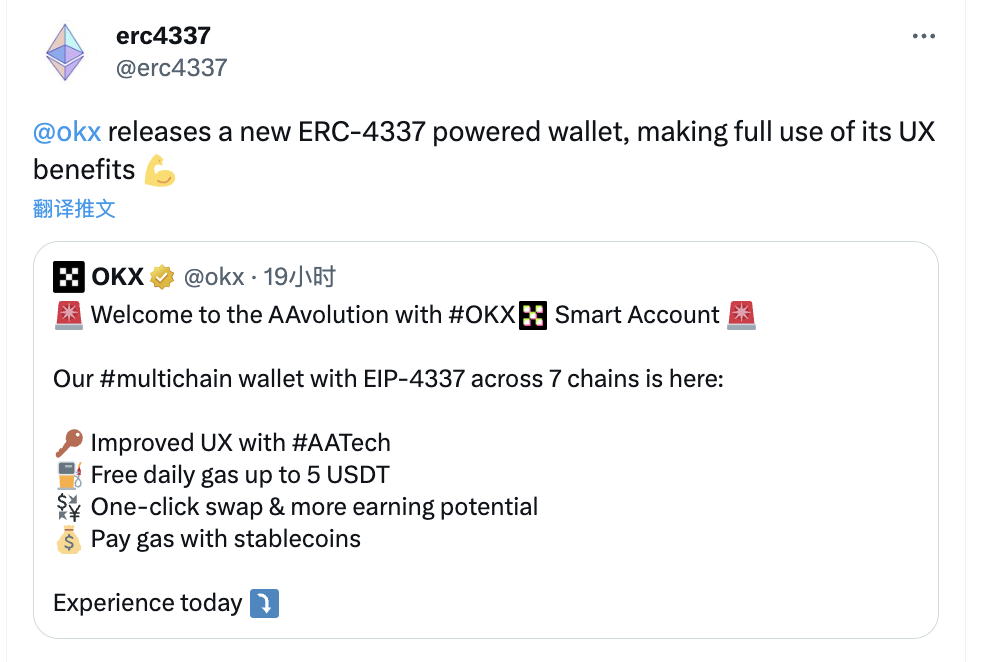
The proposal EIP is a way to publicly solicit and discuss measures to improve Ethereum, allowing the community to work closely together to make Ethereum more efficient. Any content of an Ethereum update comes from EIP, and anyone can create an EIP, but it needs to go through review, including several stages of initial discussion, feedback, and revision. ERC is a formal standard, such as the well-known ERC20, ERC721, ERC1155, etc. Ethereum founder Vitalik Buterin has stated that the implementation of the ERC-4337 proposal "will open the door to creativity for wallet design" and that the proposal will reshape the design of Ethereum wallets. If successfully implemented, it could be the key to realizing the dreams of "account abstraction" and "social recovery."
It is worth mentioning that due to the native support of abstract accounts at the chain level by Layer2 public chains such as StarkNet and ZkSync Era, it is possible to support the construction of abstract accounts without the need for the 4337 standard implementation, such as the Argent and Braavos wallets.
In summary, the excellent performance of account abstraction in signature algorithms, functional implementation, user experience, and other aspects has become a "must-have" for the large-scale application of Web3 wallets, and is worth everyone's expectation. Based on this background, OKX has taken the lead in researching and launching the AA smart contract wallet. It is worth noting that the launch of the AA smart contract wallet involves a large number of smart contracts and high difficulty and requirements for contract-side stress testing, without a unified security standard, but we will not delve into this here.
Use Cases
After discussing the principles and background at length, the following will use the use cases of the OKX AA smart contract wallet to help users understand its innovations and the new experiences it has achieved.
Paying Gas with Stablecoins. When using a regular Web3 wallet for transactions, it requires the use of the main network token (ETH) as gas fees. If the wallet does not have the main network token (ETH), transactions cannot be conducted. In addition to supporting the use of the main network token (ETH), the OKX AA smart contract wallet now also supports paying gas with stablecoins such as USDT/USDC, and will support other ERC20 tokens for gas payments in the future, removing the dependence on the main chain token for gas, making it more user-friendly and convenient.
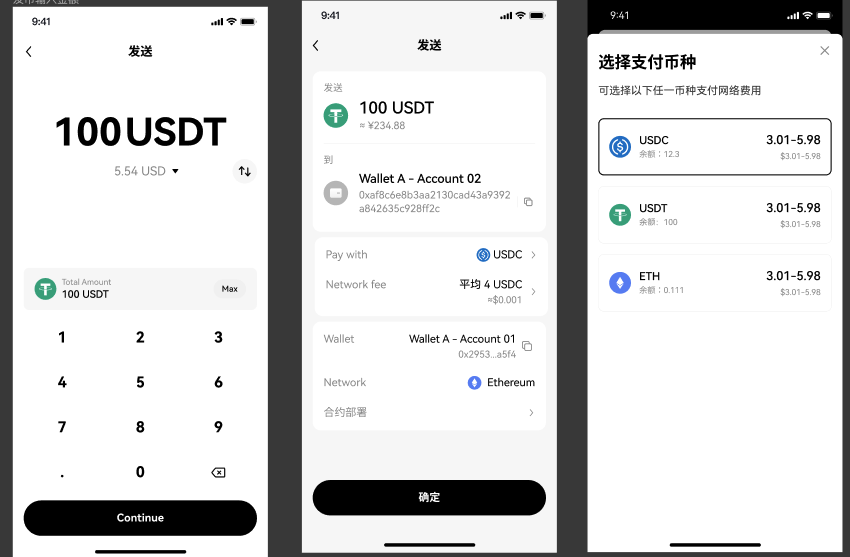
Support for Multiple Chains. OKX currently supports users in creating AA smart contract wallets on seven major mainstream public chains, including Ethereum, OKTC, Arbitrum, Polygon, Optimism, BNB Chain, and Avalanche.
One-Click DEX Swaps. The OKX AA smart contract wallet combines multiple steps that were previously required for regular account interactions into a single step. For example, it combines the previous DEX authorization (Approve) and transaction (swap) into a single call data, allowing users to complete the operation in one step for one-click swaps on decentralized exchanges (DEX).
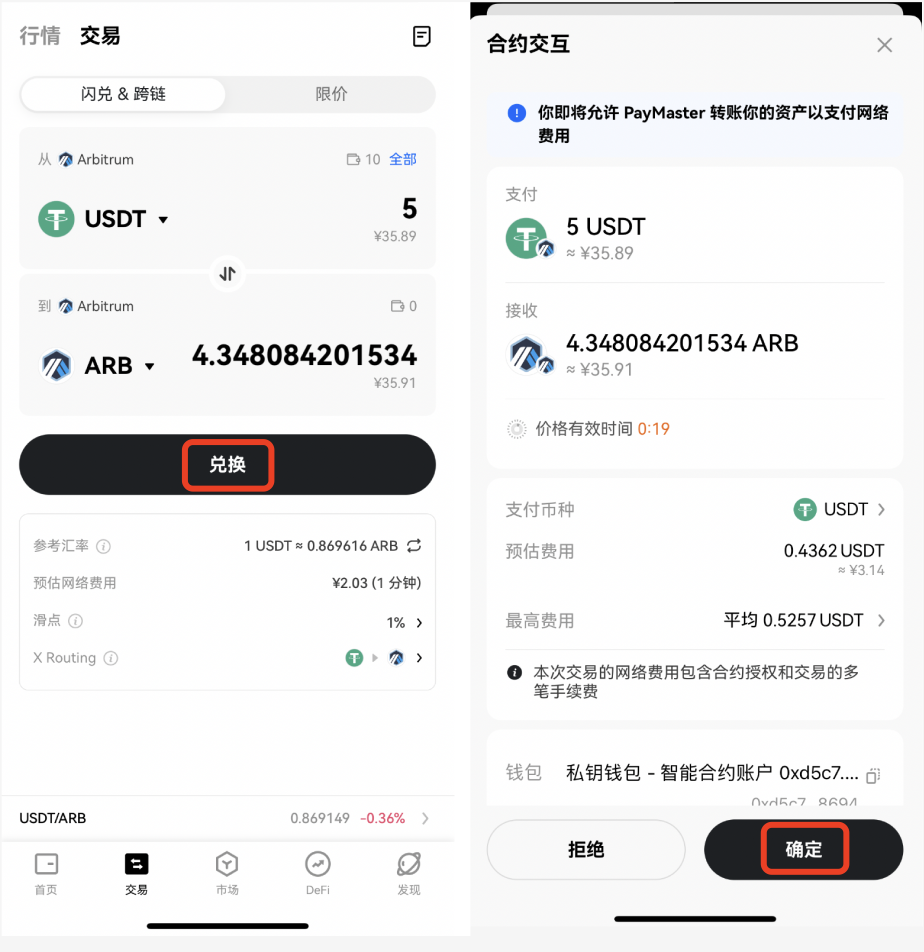
One-Click DeFi Mining. Similar to the OKX DEX one-click swap, the AA smart contract account can combine various investment operations, allowing users to execute multiple investment and rebalancing operations in one click, greatly improving efficiency.
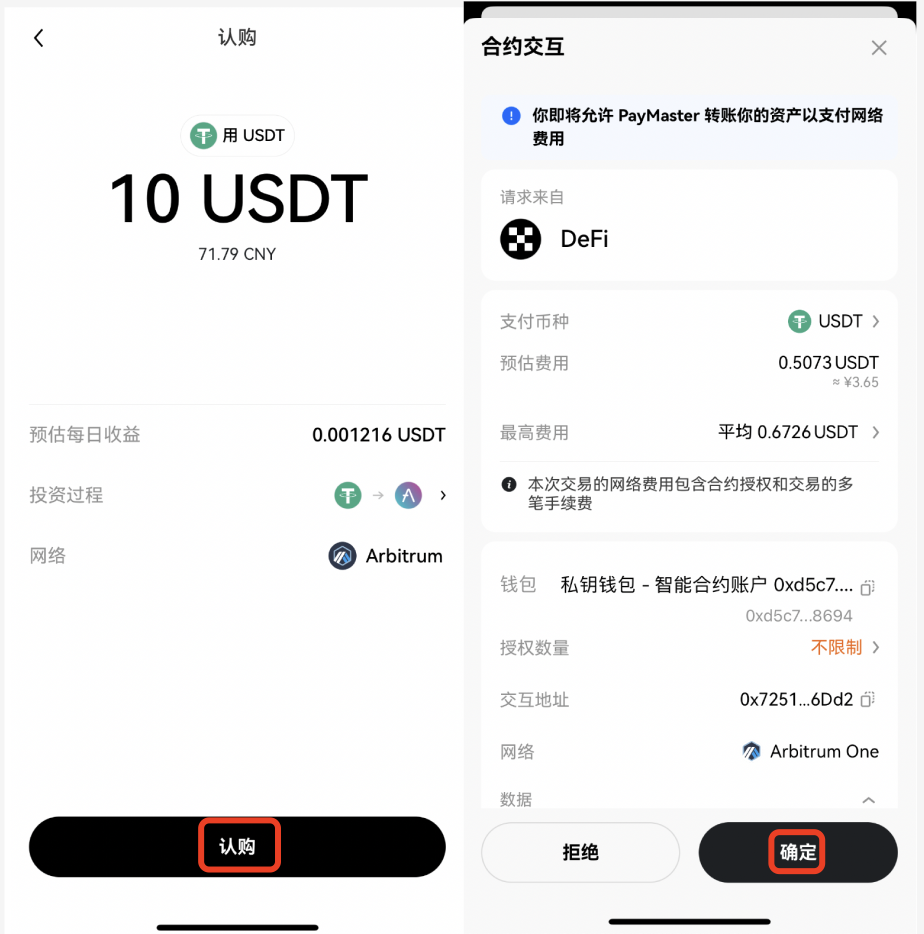
In addition to the highlighted features mentioned above, the OKX AA smart contract wallet has also launched a gas subsidy activity, allowing users to enjoy one gas fee waiver per day when transferring or trading, with a maximum waiver of 5U. In the future, the OKX AA smart contract wallet will also support social recovery, provide wallet mini-program components, enable friend and family gas payment, on-chain multi-signature functionality, and combinable operations for advanced on-chain financial strategies.
Imagine, once the social recovery feature is launched, we will bid farewell to the era where "losing the mnemonic phrase means losing the account." Users will no longer need to write down 12 words or private keys on paper. Even if the mnemonic phrase is lost, the assets will be safe, and users can access the account again through multi-factor authentication, enjoying a smooth Web2-like experience. Once the automatic execution feature is launched, transactions will run automatically when the user-defined conditions are met, similar to Alipay's password-free payment. This means that in the future, in scenarios such as blockchain games, Web3 social interactions, and high-frequency on-chain transactions, transactions will be automatically authorized and signed after meeting the requirements, greatly improving the user experience.
However, account abstraction wallets are not "perfect" and still have many aspects that need improvement. For example, since all logic of account abstraction wallets runs on the chain, it increases gas costs, and due to the dependence on smart contracts, deployment on the chain may not be compatible with other chains, and there is an increased risk of contract vulnerabilities.
Creation
How to Create the OKX AA Smart Contract Wallet?
Users can add the corresponding AA smart contract account to their existing account in different wallet types (mnemonic wallet, private key wallet, non-private key wallet, hardware wallet) provided by the OKX Web3 wallet. Each AA smart contract account is generated by a regular account to control on-chain behavior and account recovery.
For new users using the wallet for the first time, the OKX Web3 wallet provides two ways to create a wallet: non-private key wallet and mnemonic phrase. For existing wallet users, they can import the wallet through four methods: restoring the non-private key wallet, restoring from the cloud (iCloud, Google Drive, Huawei Cloud), mnemonic phrase, and private key.
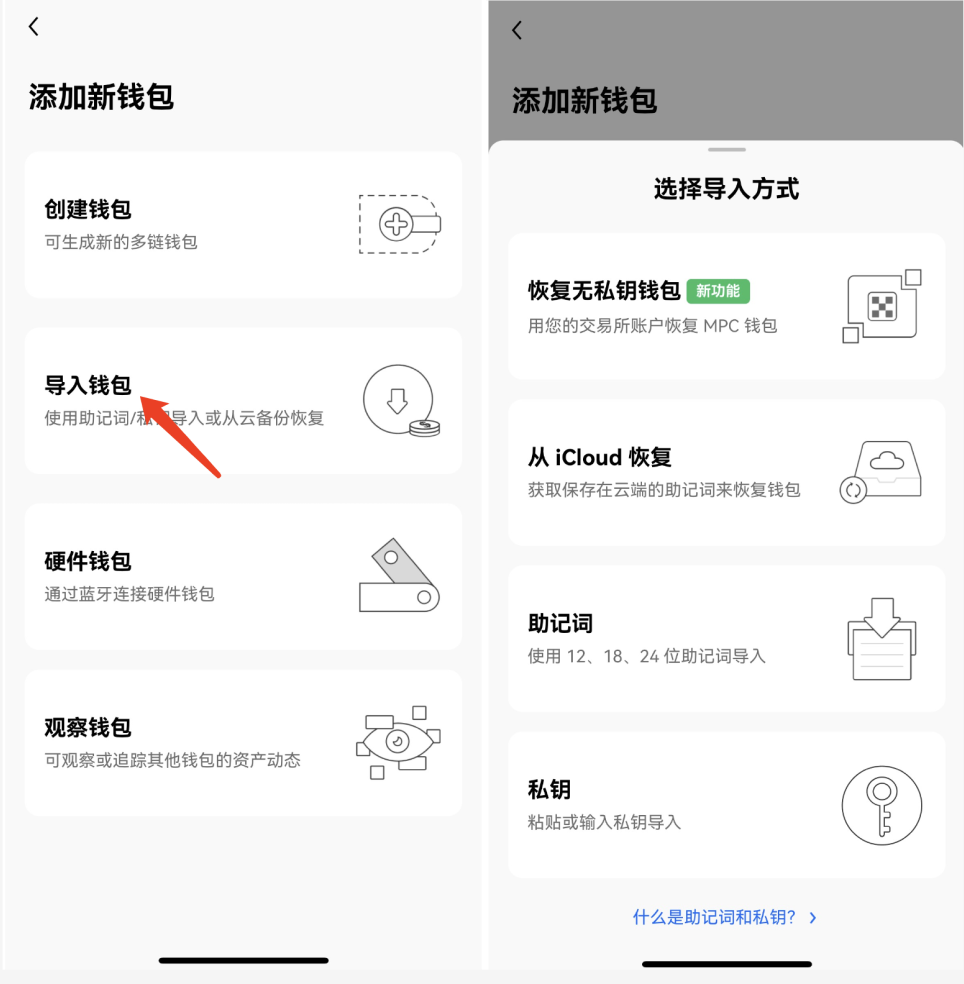
After completing the wallet creation or import, users can click ▼ > Add Account > Smart Contract Account on the wallet homepage to successfully create the AA smart contract account.
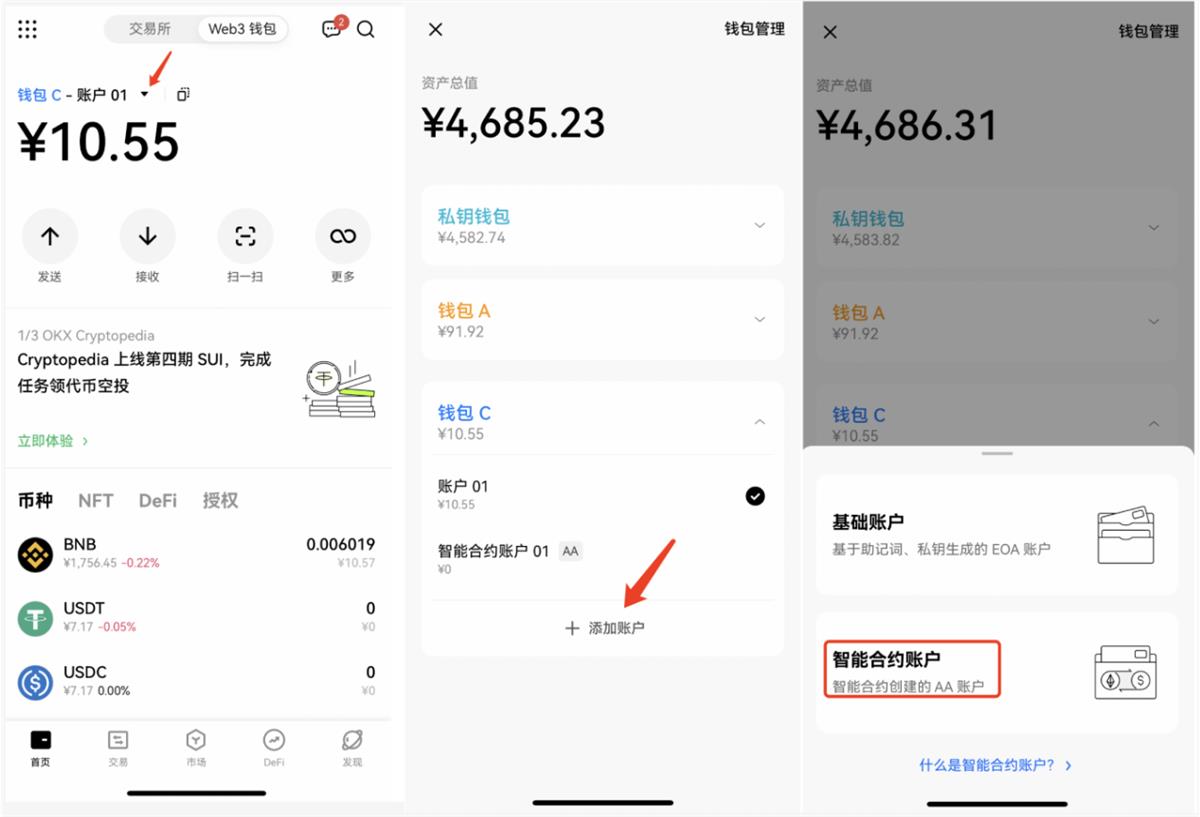
In the OKX Web3 wallet, each non-private key wallet or private key wallet can only create one AA smart contract account, while each account under the mnemonic wallet can create the corresponding AA smart contract account. For example, Wallet A - Account 01 corresponds to Wallet A - Smart 01.
Future
The past is about cognition, but the future is about trends, and it is crucial for companies to perceive and grasp future trends.
Although the EIP-4337 solution is not yet mature, and developing account abstraction wallets based on it is not easy, the ultimate goal of Ethereum is to remove EOA accounts from the Ethereum network, and the AA smart account is undoubtedly the future choice, providing developers with a high degree of freedom, helping users reduce entry barriers, and bringing more possibilities and opening up huge imagination space for Web3 wallets.
Currently, only a few technology companies like OKX have the early accumulation of encrypted wallet technology and have begun to lead and promote the development of AA smart contract wallets, continuously exploring and improving the value and experience of daily user use.
In recent years, as the world's second-largest cryptocurrency exchange, OKX is not eager to reach the top, but is returning to "first principles," rethinking the original intention of the enterprise and the path it will take in the future, and accurately grasping user needs, while also exploring decentralized business and focusing on Web3 wallets.
Just as the greatness of the iPhone is not about pioneering the smartphone, but about making the smartphone a mass product. As a product used frequently by users every day, OKX is starting to think about Web3 wallet products like "novice" users, continuously reducing their usage barriers. As Steve Jobs said, "Simplicity is the ultimate sophistication. It takes a lot of hard work to make something simple," and the OKX AA smart contract wallet is about "making something simple," pursuing the ultimate user-friendly experience. Although it is not possible to immediately convert existing EOA users into AA smart contract wallet users, it brings the possibility of large-scale application of Web3 wallets.
According to a 2022 survey, as many as 1.7 billion people worldwide do not have bank accounts and are excluded from the modern financial system. Platforms like OKX are building Web3 tools that can allow these people to enjoy inclusive and equal financial services, bringing deeper liquidity and more users to Web3.
Indeed, "the size of the world depends on the scope."
免责声明:本文章仅代表作者个人观点,不代表本平台的立场和观点。本文章仅供信息分享,不构成对任何人的任何投资建议。用户与作者之间的任何争议,与本平台无关。如网页中刊载的文章或图片涉及侵权,请提供相关的权利证明和身份证明发送邮件到support@aicoin.com,本平台相关工作人员将会进行核查。




